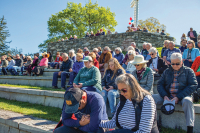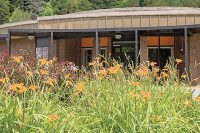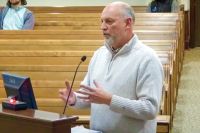Dillsboro misses out on lion’s share of flood relief
It appears Dillsboro is getting the short end of the stick in state grant money intended to revitalize business districts that flooded during the hurricanes of 2004 that swept across Western North Carolina.
Dillsboro will get as little as $20,000 from a pool of $5 million set aside for economic revitalization in flooded business districts. Neighboring Bryson City will get $400,000, even though more businesses were flooded in Dillsboro than in Bryson City. At least four businesses in Dillsboro sustained damage from rising water in their stores and had to close for repairs, and one was condemned and closed for good. In Bryson City’s downtown, just one business faced flood repairs to their building.
The discrepancy between Dillsboro and Bryson City is one of several inconsistencies in the distribution of the business redevelopment money for flooded districts.
An article in The Smoky Mountain News two months ago analyzed how the $5 million was distributed. The analysis found grants were not comparable to the level of damage or long-term economic impacts the business district suffered.
For example, no businesses were flooded in Chimney Rock, but the town got $150,000. No businesses were flooded in Crossnore either, but the town got $100,000.
State legislators set aside the $5 million for “economic recovery and redevelopment in business areas that sustained storm damage,” according to the bill. The Rural Center, a non-profit agency, was put in charge of handing out the money.
Related Items
The Rural Center initially capped the maximum grant at $700,000 so the hardest hit towns — namely Canton, Clyde, Asheville and Newland — wouldn’t suck up all the money and leave none for other places. But now, the Rural Center has decided the hardest hit towns deserve more after all and have divided unspent money between them.
“When there was extra money left over, there was a clear signal from the legislators to the Rural Center that that money was going to go to the areas with the greatest needs,” said Rep. Ray Rapp, D-Mars Hill.
That will mean an extra $120,000 for economic development in Canton’s and Clyde’s business districts, $80,000 for Asheville and $116,000 for Newland.
Some business owners in Canton and Clyde did not understand why their economic development grants were capped in an effort to reserve money for other areas that may not have suffered lasting negative consequences from the flood. Numerous businesses in Canton and Clyde closed for good, leaving rows of condemned buildings downtown, while others barely hung on after foot traffic vanished in the wake of the floods.
“We were trying to go into a small mountain village that had its business area inundated for a period of time that affected that area’s ability to serve as a heart for the area,” Rural Center President Billy Ray Hall said of the grants to Canton and Clyde.
In Bryson City, meanwhile, long-term economic repercussions from the flood are barely detectable. Same in Chimney Rock. Even Hot Springs and Marshall are back to normal by now, according to business owners there.
One tangible indication of flood impacts to business districts is a tally conducted by the Small Business Administration, the only government agency that offered help to individual businesses in the form of low-interest loans. In Swain County there was a total of $66,000 in flood repairs eligible for SBA loans, compared to $324,000 in eligible flood repairs in Jackson County.
Legislators weigh in
Sen. Keith Presnell, R-Burnsville, said he has not followed how the money was given out.
“It is so hard for me to truly say,” Pressell said when asked whether the distribution was fair.
Rep. Phil Haire, D-Sylva, said he would have to examine the criteria and look at how much each town got before deciding whether it was fair. When Haire learned Chimney Rock got $150,000 but only sustained $60,000 in flood damage to a greenway — $40,000 of which was covered by FEMA — Haire said that he would look into it. Chimney Rock is using the money to build a parking deck in the shopping distict.
“A parking area in Chimney Rock certainly would be economic development. If people have a place to park it could bring more people downtown. But I think what we had in mind is we were looking more at places that had suffered like Canton and Clyde to help shore them back up,” Haire said. “It was my understanding it was to do exactly what it says, to help towns get back on their feet and become viable.”
Rep. Rapp, D-Mars Hill, has followed flood recovery money more closely. He said that if the Rural Center erred, it erred on the side of flood victims by giving them the benefit of the doubt.
“When you are out of the box for the first time on these things you want to be as inclusive as possible and not so squeaky tight that people don’t get the assistance they need,” Rapp said.
This disaster marks the first time legislators have allocated money for general economic redevelopment. Rapp promoted the idea of economic development money after attending meetings with business owners in Canton and Clyde who shared horror stories of losing their merchandise, buildings and equipment and getting nothing but a loan in the form of aid — a loan they would have trouble paying back since they were temporarily out of business and luring customers back to the flood district was a long shot.
Rapp said the method for passing out the economic revitalization money could use some fine-tuning next time.
“I do want verification. This is not a give-away program. This is to help legitimate needs,” Rapp said. “They will have some additional hoops to jump through before the check is written.”
Which pool of money
Out of 14 grant applications, the Rural Center only turned down one. Vetting of West Jefferson’s application determined the town did not have sufficient flood damage to qualify for the grant money. West Jefferson’s application was pending at the time of the Smoky Mountain News article two months ago. Money reserved for West Jefferson — had its application panned out — is part of the extra money made available to the hardest hit areas.
Initially, the Rural Center did not require proof of flooding as part of the application process. After it announced grant winners and after media inquiries, the Rural Center went back and asked for verification of flooding from towns that had failed to do so initially.
Hall, president of the Rural Center, said the vetting process considered more than just the number of businesses that flooded or closed in a business district. Hall said flooding in the streets or town infrastructure could hurt the business district without touching the buildings.
In Bryson City, a bridge that provided access to a downtown park was destabilized by the floods, shutting off access to the park, Hall said. As a result, the downtown area lost one of its anchor attractions, thus hurting the business district.
Physical damage to streets and public infrastructure was largely covered by FEMA and other state money, however. For example, flooding in Chimney Rock spared businesses but washed out part of the town’s river walk, thus qualifying the business district as having flooded. It cost $60,000 to repair the riverwalk, of which FEMA paid $40,000. Despite no other tangible flood damage to the business district than the river walk largely covered by FEMA, Chimney Rock got $150,000 out of the business economic redevelopment pool.
Bryson City’s footbridge could have been covered by FEMA, too, but neither the county nor town applied in time. So instead, business revitalization money from the Rural Center will go toward repairing the bridge. Businesses were not damaged in Crossnore, but the community building was. The town got both FEMA money and money from the Rural Center to fix it up.
Hall said the vetting process also took into consideration how much grant money an area was getting from other sources.
“What is the total amount of money they are getting from all those different sources?” Hall said of the decision process.
Canton has gotten millions in flood relief money from FEMA and the state. But none of it was for economic development and revitalization in flooded business districts. The only help offered to flooded businesses are loans from the Small Business Administration.
Chris Revay, the owner of a Clyde bookkeeping business called Data Management, said businesses that have just lost all their merchandise, equipment and their building are not in a position to be borrowing the capital they need to get back up and running. Revay said the only assistance businesses got was from the Haywood County Economic Development Commission, which gave out grants ranging from $1,000 to $5,000.
There is a striking difference with the process used by the Haywood County Economic Development Commission to pass out grants and that used by the Rural Center. A committee of five people, including the Haywood County Chamber of Commerce and Haywood Community College, visited every business impacted by the flood in person to document their estimated repair costs. Grants were then handed out according to the damage each business sustained for a total of $132,000 in grants.
The Rural Center, meanwhile, which handed out $5 million in grants, did not quantify flood impacts to the business districts.
Revay questioned why there was not similar screening for the Rural Center grants.
“There should have been some kind of reporting mechanism,” Revay said.
To read the first article on this subject, see the on-line archives at www.smokymountainnews.com.









